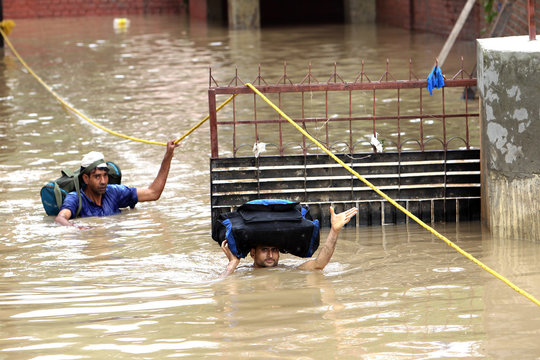Researchers say Kashmir region is more vulnerable to long spells of high intensity rains because of global climate change and the geography of the region which can increase the frequency of floods in future.
BY JEHANGIR ALI
SRINAGAR — The Indian Space Research Organization (ISRO) has warned that the intensity of rainfall and the frequency of rainy days in the Himalayan region may increase in 2030’s, which can lead to another flood in Kashmir if immediate steps are not taken to restore the drainage system of Jehlum.
A rapid assessment carried out by ISRO’s National Remote Sensing Centre and Kashmir’s Environment and Remote Sensing Department after the September floods wreaked havoc across the region says the frequency of rainy days is likely to decrease in most parts of the country in 2030s.
“The intensity of rainy days will increase in a more warming scenario. The number of rainy days in the Himalayan region may increase by 5-10 days on an average in the 2030s. They will increase by more than 15 days in the eastern part of the Jammu and Kashmir,” the ISRO report says.
The report says the loss of water bodies had its bearing on local micro-climate with the mean temperature in summers rising to 39.5 Celsius in 2006 as compared to 35.5 degree Celsius in 1973 which makes another flood imminent.
It says the Kashmir region is more vulnerable to long spells of high intensity rains because of global climate change and the geography of the region which can, in future, increase the frequency of floods in Kashmir.
“Many times clouds entering into the valleys are not able to escape because of high hills. They go on accumulating and ultimately burst into a high intensity rain. Himalayan water tower consisting of glaciers, snow, rainfall and lakes/wetlands has high potential of flooding being hiked by increasing number and intensity of extreme storms because of climate change,” the report says.
The projections made by the ISRO report are backed by a report prepared in 2005 by an Intergovernmental Panel on Climate Change which says that there will be an “increase in the incidences of rainfall in Asia”.
The ISRO report says the floods are going to be a “very critical issue” in Kashmir “because there is only one flood water outlet of Jhelum river and a lot of civil constructions like houses, roads, etc. is taking place along it and extreme rainfall events are going to multiply in future.”
The report has recommended that an alternate flood spill channel for Jehlum must be dug up. “Feasibility study for digging a flood channel from Sanagam/Kandizal to Wular should be carried out. The spill channel running across Peerbagh and Nambali-Narkur can be widened to receive the waters of Doodhganga Nallah,” it says.
The report says that the bunds and embankments of Jehlum should be raised so that the low lying areas around them are safe. It has also recommended that the natural existing drainage networks of Jehlum must be made “viable.”
“Improvement in the river flood channels to hold water beyond 35000 cusecs with current capacity of 15000 cusecs by a comprehensive de-siltation programme both for river Jhelum and its tributaries. Retrofitting of dangerous buildings, flood zoning, relocation of buildings very close to the river banks, strict regulations to check future interferences with drainage system, restoration of wetlands and river training works will be able to minimize infrastructural damages and human miseries,” the report says.
Over 280 people were killed and millions were affected by the flood which struck the region in the first week of September. The economic losses caused by the deluge are estimated to run in billions of dollars with many businesses closing down in the wake of a liquidity crunch.
So far, the government has not announced any major rehabilitation package for the affected people, many of whom continue to live in makeshift tents. With the winters approaching fast, the anger is growing in the region which is going to polls on November 25.

